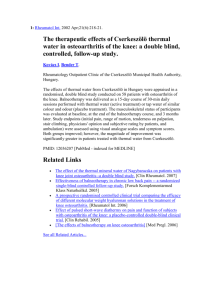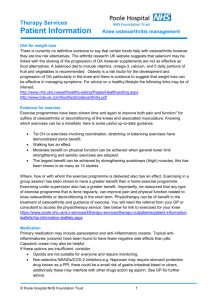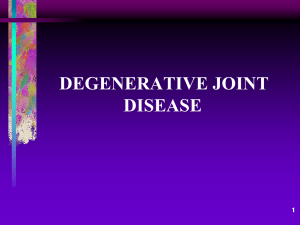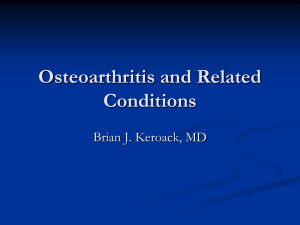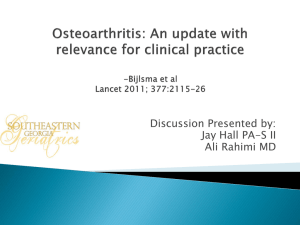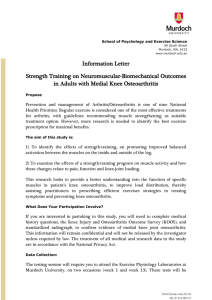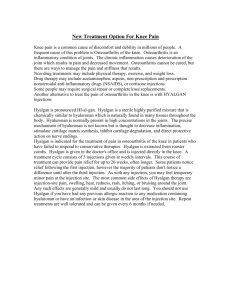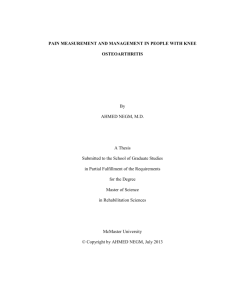Is multidisciplinary management of chronic low back pain more
advertisement
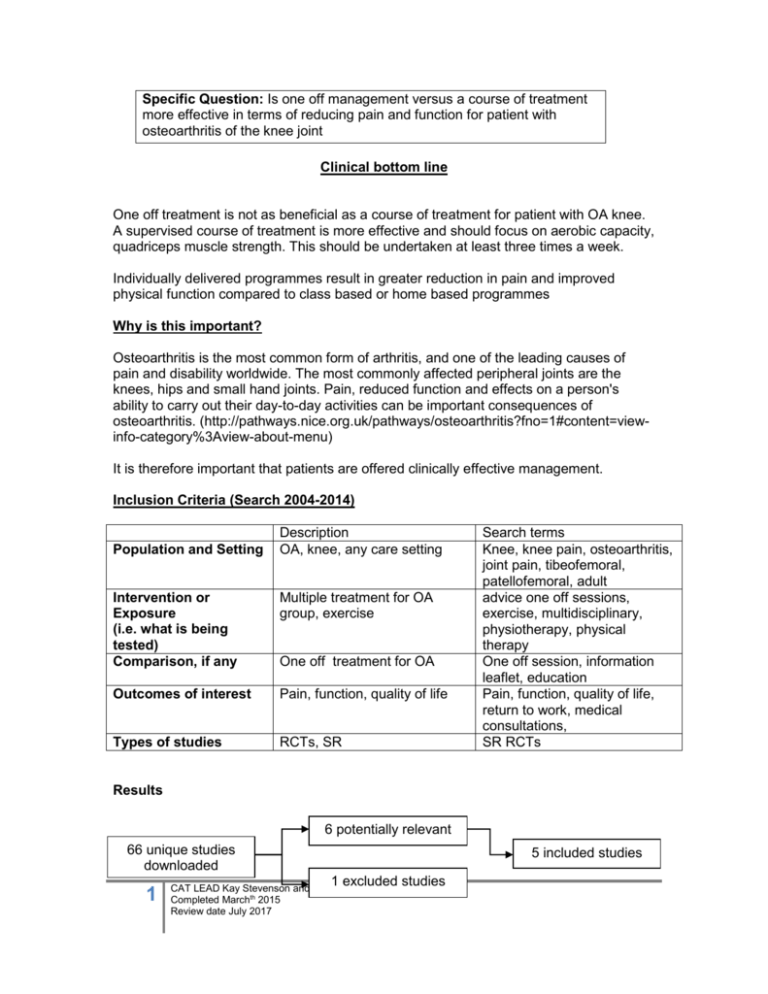
Specific Question: Is one off management versus a course of treatment more effective in terms of reducing pain and function for patient with osteoarthritis of the knee joint Clinical bottom line One off treatment is not as beneficial as a course of treatment for patient with OA knee. A supervised course of treatment is more effective and should focus on aerobic capacity, quadriceps muscle strength. This should be undertaken at least three times a week. Individually delivered programmes result in greater reduction in pain and improved physical function compared to class based or home based programmes Why is this important? Osteoarthritis is the most common form of arthritis, and one of the leading causes of pain and disability worldwide. The most commonly affected peripheral joints are the knees, hips and small hand joints. Pain, reduced function and effects on a person's ability to carry out their day-to-day activities can be important consequences of osteoarthritis. (http://pathways.nice.org.uk/pathways/osteoarthritis?fno=1#content=viewinfo-category%3Aview-about-menu) It is therefore important that patients are offered clinically effective management. Inclusion Criteria (Search 2004-2014) Population and Setting Description OA, knee, any care setting Intervention or Exposure (i.e. what is being tested) Comparison, if any Multiple treatment for OA group, exercise Outcomes of interest Pain, function, quality of life Types of studies RCTs, SR One off treatment for OA Search terms Knee, knee pain, osteoarthritis, joint pain, tibeofemoral, patellofemoral, adult advice one off sessions, exercise, multidisciplinary, physiotherapy, physical therapy One off session, information leaflet, education Pain, function, quality of life, return to work, medical consultations, SR RCTs Results 6 potentially relevant 66 unique studies downloaded 1 5 included studies 1 excluded studies CAT LEAD Kay Stevenson and Prof Dziedzic Completed Marchth 2015 Review date July 2017 First Author, year and type of study Fransen et al 2015 Cochrane systematic review Population and setting People with OA 54 RCTs Intervention or exposure tested Comparing land based exercise with a nonexercise group. Outcomes: joint pain, improved physical function and QoL Juhl et al 2014 Systematic review Patients with OA as defined by ACR criteria, 48 RCTs Trials compared exercise to a non-exercise group. Aim: To identify optimal exercise programme in terms of type, intensity, length and duration and number of sessions per week. Wang et al 2012 Systematic review Community dwelling adults with knee OA. 193 RCTs Interventions considered within scope of physiotherapy practice Pain, QoL, 2 CAT LEAD Kay Stevenson and Prof Dziedzic Completed Marchth 2015 Review date July 2017 Study results High quality evidence from 44 trials (3537 participants) indicates exercise reduces pain. Assessment of quality and comments GRADE used to assess quality 20% trials had low risk of bias Moderate quality evidence from 44 trials (3913 participants) that exercise improved physical function. High quality evidence from 13 trials (1073 participants) to suggest exercise improves quality of life Individually delivered programmes tend to result in greater reductions in pain and improved physical function compared to class based or home based programmes. Similar effects for reducing pain found for aerobic, resistance and performance exercise. Single type exercise programmes more efficacious than mixing different exercise types. Clear search, no language or date restrictions and checked reference lists. Tested for heterogeneity More pain reduction with quadriceps specific exercises compared to lower limb exercise, when sessions were supervised and performed at least 3 times a week. Used 2 reviewers More than 70% were female, most participants over weight Clear search strategy Only 83 studies on 13 physio interventions met pooling criteria for Clear inclusion and exclusions Assessed bias but not using recognised tool but criteria mentioned within the article. Assessed risk of perceived health status, strength, global assessment of effectiveness Included dose, length, intensity of interventions when reported by authors Proprioceptive exercises improved pain Aerobic exercises led to statistically significant improvement in long term pain (>26 weeks), also improved function and gait Aquatic exercises reduced disability but had no effect on pain or QOL bias Assessed strength of evidence using GRADE Most trials had moderate risk of bias, numbers were small Strengthening exercises reduced pain but had no effect on disability or QoL Pisters Systematic review 2007 Included RCTs, controlled trials, follow up at least 6 months after treatment had ended To determine long term effectiveness (over 6 months) of exercise therapy on pain, physical function and patient global assessment of effectiveness Outcomes pain, self report physical function, patient global assessment of effectiveness 5 high quality and 6 low quality trial included Appropriate lit search Strong evidence for no long term effect on pain and self reported physical function Appropriate review of articles, quality assessed by 2 reviewers Moderate evidence for long term effectiveness on patient assessment of effectiveness Criteria list used (Cochrane) Moderate evidence for additional booster sessions having long term effect on pain, self reported physical function and observed physical function Summary One off treatment is not as beneficial as a course of treatment for patient with OA knee There is good quality systematic review evidence to suggest supervised and individually delivered exercises programmes focusing on aerobic capacity, quadriceps muscle strength or lower limb performance reduce pain and improve function. Benefits are increase with supervision and when undertaken at least 3 times a week (Juhl 2014) A recently updated Cochrane systematic review (Fransen 2015) highlighted high and medium quality evidence to support the use of individually delivered programmes over class or home based programme with respect to improvements in pain and function. The benefit is sustained for at least 2-6 month Juhl (2014) suggests single type exercises programmes were more efficacious than mixing exercise type. 3 CAT LEAD Kay Stevenson and Prof Dziedzic Completed Marchth 2015 Review date July 2017 Exercise (i.e. aquatic, strengthening, proprioceptive and aerobic) results in statistically and clinically significant reduction in pain. Exercise combined with high adherence and when supervised by a physiotherapist is associated with better outcomes for patients (Wang et al 2012). To achieve long term effects, booster sessions may be required to extend these benefits extend beyond 6 months (Pisters et al 2007). Conclusions The management of knee OA should not be confined to a one off session, the benefits for the patient are realised through supervised individualised exercise programmes, where the patient attends at least 3 times a week. Exercise programmes may be aquatic, strengthening, proprioceptive or aerobic. Greater adherence to the exercises will result in better outcome for patients. It may also be beneficial to have refresher or booster sessions to help maintain the positive effects seen immediately after treatment. There is some suggestion that there is no benefit in mixing exercise types, but to focus on one element e.g. strengthening References Fransen M McConnel S Harmer AR van der Esch M Simic M Bennell KL Exercise for osteoarthritis of the knee Cochrane Database Systematic Review 2015 Jan 9;1 Julhl C, Christensen R, Roos EM, Zhang W, Lund H Impact of exercise type and dose on pain and disability in knee osteoarthritis: a systematic review and meta-regression analysis of randomised controlled trials Arthritis and Rheumatism 2014; 66(3) 622-636 Wang S, Olson- Kellog B, Shamilyan TA, Choi JY Ramakrishnan, Kane RL Physical Therapy Interventions for Knee pain secondary to osteoarthritis Ann Int Medicine 2012 Vol 157 number 9 National Institute for Health and Care Excellence. NICE Pathways: Osteoarthritis. Available from http://pathways.nice.org.uk/pathways/osteoarthritis. 4 CAT LEAD Kay Stevenson and Prof Dziedzic Completed Marchth 2015 Review date July 2017


